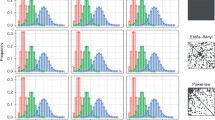Abstract
Random matching between individuals, or the complete-mixing model, is often assumed in analyzing evolutionary or population dynamics in ecology and game theory or other models in social sciences. Making and analyzing a model is not difficult under this simple assumption. However spatial- or network-structured populations, including the lattice model and the power-law network, are more realistic for many ecological and social phenomena than the complete-mixing model. In this review, I will show first that a lattice model can be useful in investigating the effect of neighborhood interactions on the dynamics, not only of plants and forests, but also of animal and human societies. Second, the lattice model promotes the evolution of spiteful behavior, even though it is well-known that the lattice model promotes the evolution of cooperation. Finally, different social networks result in traits, such as social norms, spreading at different speeds.



Similar content being viewed by others
References
Aoki M (2001) Toward a comparative institutional analysis. MIT Press, Cambridge
Barabasi A (2002) Linked: the new science of networks. Perseus, Cambridge
Barabasi A, Albert R (1999) Emergence of scaling in random networks. Science 286:509–512
Carlson RO (1965) Adoption of educational innovations. Center for the Advanced Study of Educational Administrations, University of Oregon, Eugene
Cavalli-Sforza LL, Feldman MW (1981) Cultural transmission and evolution: a quantitative approach. Princeton University Press, Princeton
Chao L, Levin BR (1981) Structured habitats and the evolution of anticompetitor toxins in bacteria. Proc Natl Acad Sci USA 78:6324–6328
Clutton-Brock TH, Parker GA (1995) Punishment in animal societies. Nature 373:209–216
Czaran T (1998) Spatiotemporal models of population and community dynamics. Chapman & Hall, London
Durrett R, Levin SA (1997) Allelopathy in spatially distributed populations. J Theor Biol 185:165–171
Ellner PS, Sasaki A, Haraguchi Y, Matsuda H (1998) Speed of invasion in lattice population models: pair-edge approximations. J Math Biol 36:469–484
Erdos P, Renyi A (1960) On the evolution of random graphs. Publ Math Inst Hung Acad Sci 5:17
Flack JC, Girvan M, de Waal FB, Krakauer DC (2006) Policing stabilizes construction of social niches in primates. Nature 439:426–429
Gilbert N, Troitzch K (1999) Simulation for the social scientist. Open University Press, Buckingham
Glimcher PW, Rustichini A (2004) Neuroeconomics: the consilience of brain and decision. Science 306:447–452
Hamilton WD (1964) The genetical evolution of social behavior. J Theor Biol 7:1–52
Hanski I (1999) Metapopulation ecology. Oxford University Press, Oxford
Henrich J, Boyd R (2001) Why people punish defectors: weak conformist transmission can stabilize costly enforcement of norms in cooperative dilemmas. J Theor Biol 208:79–89
Iwasa Y, Nakamaru M, Levin SA (1998) Allelopathy of bacteria in a lattice population: competition between colicin-sensitive and colicin-producing strains. Evol Ecol 12:785–802
Kossinets G, Watts DJ (2006) Empirical analysis of an evolving social network. Science 311:88–90
Kubo T, Iwasa Y, Furumoto N (1996) Forest dynamics with gap expansion: total gap area and gap size distribution. J Theor Biol 180:229–246
Levin SA (1999) Fragile dominion. Perseus, Cambridge
Liljeros F, Edling CR, Amaral LAN, Stanley HE, Aberg Y (2001) The web of human sexual contacts. Nature 411:907–908
Macy MW, Sato Y (2002) Trust, cooperation, and market formation in the U.S. and Japan. Proc Natl Acad Sci USA 99:7214–7220
Matsuda H, Tamachi N, Ogita N, Sasaki A (1987) A lattice model for population biology. In: Teramoto E, Yamaguchi M (eds) Mathematical topics in biology: lecture notes in biomathematics, vol. 71. Springer, Berlin Heidelberg New York, pp 154–161
Matsuda H, Ogita N, Sasaki A, Sato K (1992) Statistical mechanics of population—the lattice Lotka-Volterra model. Prog Theor Phys 88:1035–1049
Matsui A (1992) Best response dynamics and socially stable strategies. J Econ Theor 57:343–362
Nakamaru M, Iwasa Y (2005) The evolution of altruism by costly punishment in the lattice structured population: score-dependent viability versus score-dependent fertility. Evol Ecol Res 7:853–870
Nakamaru M, Iwasa Y (2006) The coevolution of altruism and punishment: role of the selfish punisher. J Theor Biol (in press)
Nakamaru M, Kawata M (2004) Evolution of rumors that discriminate lying defectors. Evol Ecol Res 6:261–283
Nakamaru M, Levin SA (2004) Spread of two linked social norms on complex interaction network. J Theor Biol 230:57–64
Nakamaru M, Matsuda H, Iwasa Y (1997) The evolution of cooperation in a lattice-structured population. J Theor Biol 184:65–81
Nakamaru M, Nogami H, Iwasa Y (1998) Score-dependent fertility model for the evolution of cooperation in a lattice. J Theor Biol 194:101–124
Newman MEJ (2002) Spread of epidemic disease on networks. Phys Rev E 66:016128
Nowak MA, May RM (1992) Evolutionary games and spatial chaos. Nature 248:715–718
Odling-Smee FJ, Laland KN, Feldman MW (2003) Niche construction. Princeton University Press, Princeton
Palla G, Derenyi I, Farkas I, Vicsek T (2005) Uncovering the overlapping community structure of complex networks in nature and society. Nature 435:814–818
Sigmund K, Hauert C, Nowak M (2001) Reward and punishment. Proc Natl Acad Sci USA 98:10757–10762
Watts DJ, Strogatz SH (1998) Collective dynamics of small-world networks. Nature 393:1302–1305
Watts DJ, Dodds PS, Newman MEJ (2002) Identity and search in social networks. Science 296:1302–1305
Wilson DS, Pollock GB, Dugatkin LA (1992) Can altruism evolve in purely viscous populations? Evol Ecol 5:220–230
Acknowledgements
This work was done with the support of a JSPS Grant-in-Aid to M.N. (No.17770014). I thank Professor Yoh Iwasa and the Inamori Foundation for giving me an opportunity to present a lecture in the workshop celebrating the 2005 Kyoto Prize Laureate, Professor Simon A. Levin. I also thank anonymous referees for their helpful comments.
Author information
Authors and Affiliations
Corresponding author
About this article
Cite this article
Nakamaru, M. Lattice models in ecology and social sciences. Ecol Res 21, 364–369 (2006). https://doi.org/10.1007/s11284-006-0163-0
Received:
Accepted:
Published:
Issue Date:
DOI: https://doi.org/10.1007/s11284-006-0163-0




